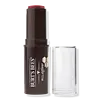Burt's Bees 100% Natural All Aglow Lip & Cheek Stick Versus bareMinerals Mineralist Lasting Matte Liquid Lipstick
What's inside
What's inside
 Key Ingredients
Key Ingredients

 Benefits
Benefits

 Concerns
Concerns

 Ingredients Side-by-side
Ingredients Side-by-side

Simmondsia Chinensis Seed Oil
EmollientHelianthus Annuus Seed Oil
EmollientCera Alba
EmollientBeeswax
Emulsion StabilisingCocos Nucifera Oil
MaskingRaphanus Sativus Seed Extract
Skin ConditioningRicinus Communis Seed Oil
MaskingLauryl Laurate
Skin ConditioningMica
Cosmetic ColorantTheobroma Grandiflorum Seed Butter
Skin ConditioningSilica
AbrasiveRosmarinus Officinalis Leaf Extract
AntimicrobialTocopherol
AntioxidantGlycine Soja Oil
EmollientLinoleic Acid
CleansingLinolenic Acid
CleansingWater
Skin ConditioningAlumina
AbrasiveAroma
Linalool
PerfumingCI 75470
Cosmetic ColorantIron Oxides
CI 77891
Cosmetic ColorantTitanium Dioxide
Cosmetic ColorantSimmondsia Chinensis Seed Oil, Helianthus Annuus Seed Oil, Cera Alba, Beeswax, Cocos Nucifera Oil, Raphanus Sativus Seed Extract, Ricinus Communis Seed Oil, Lauryl Laurate, Mica, Theobroma Grandiflorum Seed Butter, Silica, Rosmarinus Officinalis Leaf Extract, Tocopherol, Glycine Soja Oil, Linoleic Acid, Linolenic Acid, Water, Alumina, Aroma, Linalool, CI 75470, Iron Oxides, CI 77891, Titanium Dioxide
Isododecane
EmollientCaprylic/Capric Triglyceride
MaskingTrimethylsiloxysilicate
EmollientSilica
AbrasiveHydrogenated Polyisobutene
EmollientBis-Diglyceryl Polyacyladipate-2
EmollientIsobutylmethacrylate/Bis-Hydroxypropyl Dimethicone Acrylate Copolymer
Disteardimonium Hectorite
StabilisingTribehenin
EmollientEuphorbia Cerifera Wax
Simmondsia Chinensis Seed Oil
EmollientPropylene Carbonate
SolventTocopheryl Acetate
AntioxidantPunica Granatum Flower Extract
Skin ConditioningPolyglyceryl-3 Diisostearate
EmulsifyingAroma
Ethylhexylglycerin
Skin ConditioningHippophae Rhamnoides Oil
EmollientLinalool
PerfumingCI 42090
Cosmetic ColorantIron Oxides
CI 45410
Cosmetic ColorantCI 73360
Cosmetic ColorantCI 15850
Cosmetic ColorantCI 19140
Cosmetic ColorantCI 77891
Cosmetic ColorantIsododecane, Caprylic/Capric Triglyceride, Trimethylsiloxysilicate, Silica, Hydrogenated Polyisobutene, Bis-Diglyceryl Polyacyladipate-2, Isobutylmethacrylate/Bis-Hydroxypropyl Dimethicone Acrylate Copolymer, Disteardimonium Hectorite, Tribehenin, Euphorbia Cerifera Wax, Simmondsia Chinensis Seed Oil, Propylene Carbonate, Tocopheryl Acetate, Punica Granatum Flower Extract, Polyglyceryl-3 Diisostearate, Aroma, Ethylhexylglycerin, Hippophae Rhamnoides Oil, Linalool, CI 42090, Iron Oxides, CI 45410, CI 73360, CI 15850, CI 19140, CI 77891
Ingredients Explained
These ingredients are found in both products.
Ingredients higher up in an ingredient list are typically present in a larger amount.
Aroma refers to an ingredient, or mixture of ingredients, that impart or mask a flavor.
The name is slightly confusing. This is because INCI associates aroma with flavor instead of smell.
Here is the official definition from the The International Cosmetic Ingredient Dictionary and Handbook:
“Aroma is a term for ingredient labeling used to identify that a product contains a material or combination of materials normally added to a cosmetic to produce or to mask a particular flavor.”
INCI shows the only purpose of aroma to be "flavouring".
However, due to regulation differences, some companies may use aroma in place of parfum.
In Canada, this ingredient only has to be listed in concentrations above 1%.
Learn more about AromaCi 77891 is a white pigment from Titanium dioxide. It is naturally found in minerals such as rutile and ilmenite.
It's main function is to add a white color to cosmetics. It can also be mixed with other colors to create different shades.
Ci 77891 is commonly found in sunscreens due to its ability to block UV rays.
Learn more about CI 77891Linalool is a fragrance and helps add scent to products. It's derived from common plants such as cinnamon, mint, citrus, and lavender.
Like Limonene, this ingredient oxidizes when exposed to air. Oxidized linalool can cause allergies and skin sensitivity.
This ingredient has a scent that is floral, spicy tropical, and citrus-like.
Learn more about LinaloolSilica, also known as silicon dioxide, is a naturally occurring mineral. It is used as a fine, spherical, and porous powder in cosmetics.
Though it has exfoliant properties, the function of silica varies depending on the product.
The unique structure of silica enhances the spreadability and adds smoothness, making it a great texture enhancer.
It is also used as an active carrier, emulsifier, and mattifier due to its ability to absorb excess oil.
In some products, tiny microneedles called spicules are made from silica or hydrolyzed sponge. When you rub them in, they lightly polish away dead skin layers and enhance the penetration of active ingredients.
Learn more about SilicaThis oil comes from the seeds of the desert shrub called Jojoba. It is more commonly known as jojoba oil, a non-comedogenic oil.
Jojoba oil does not contain fragrance and has many fatty-acids, making it a great soothing ingredient.
It also contains Vitamin E, a great moisturizing ingredient. Vitamin E is also an antioxidant and protects your skin against oxidative damage.
This ingredient humectant properties, meaning it helps draw moisture from the air. This helps keep your skin hydrated.
While jojoba has antibacterial properties, it is only able to kill some strains of bacteria.
Studies also show it helps in wound healing. In fact, Indigenous cultures have used jojoba as a moisturizer and to help treat burns for centuries.
Fun fact: Jojoba oil similar to natural human skin sebum, so it has a great effect on dry skin. It is also promising with helping to regulate sebum production.
Due to its fatty acid content, Jojoba oil may not be fungal acne safe. We recommend speaking with a professional if you have any concerns.
Learn more about Simmondsia Chinensis Seed OilThis ingredient is a combination of red, black, and yellow iron oxide pigments. This combination of colors is usually found in foundation, because it results in a "skin" color.